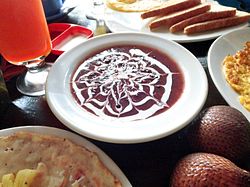This article needs additional citations for verification .(February 2025) |
 Bubur ketan hitam served with thick coconut milk served in Bali, Indonesia. | |
| Alternative names | Bubur pulut hitam |
|---|---|
| Place of origin | Indonesia [1] [2] [3] |
| Region or state | Java |
| Main ingredients | Black glutinous rice, coconut milk, palm sugar or cane sugar |
Bubur ketan hitam, bubur pulut hitam or bubur injun (English: black sticky rice porridge) is an Indonesian sweet dessert made from black glutinous rice porridge with coconut milk and palm sugar or cane sugar. The black glutinous rice are boiled until soft, and sugar and coconut milk are added. It is often described as "black glutinous rice pudding" and is very similar to black rice tong sui made from black rice. [4] It is often served as dessert or snack, for supper, for tea time, any time of the day; [5] however, it is a popular choice for breakfast for those who prefer sweet treats instead of its savory counterpart bubur ayam.




